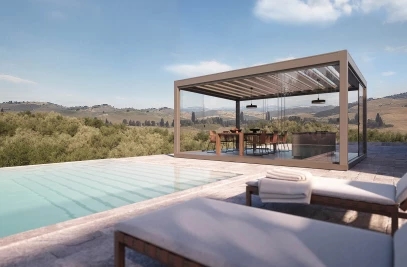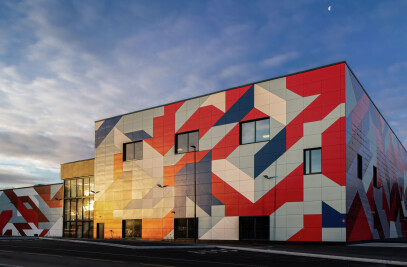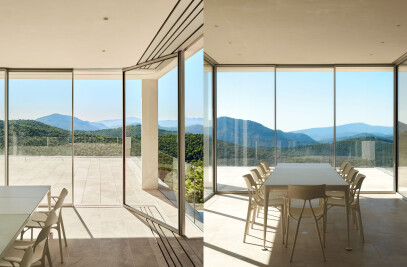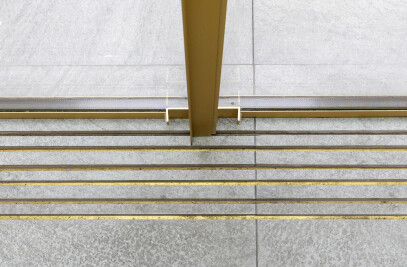ARCity Office embarked on a project that would establish a new typology of “bricolage architecture” in Nantou Ancient City, a historic site in Shenzhen, China. In a project titled “Six Bricolage Houses”, the studio renovated six self-built houses, creating an inventive model for urban renewal and housing design.
The rapid urbanization and industrialization of Shenzhen has gradually transformed Nantou (home to more than 20,000 residents and workers) into an urban village. Historic architecture has been replaced by “self-planned and independently-built residential complexes” for the rural population that relocated to Shenzhen, resulting in a chaotic urban structure. The “Six Bricolage Houses” project integrates modern architectural design into Nantou’s historic architectural fabric.
In 2017, the Shenzhen and Hong Kong Bi-City Biennale of Urbanism/Architecture (UABB) (an event with a specific focus on urbanism and urbanization) chose Nantou as the main exhibition venue. UABB kick-started a number of significant changes within the ancient city, with Nantou increasingly incorporated into Shenzhen’s ongoing urban development. In 2022/2023, UABB returned to Nantou, with artists and architects invited to create on-site works and exhibits in a tight core of inner streets and alleyways. The event’s curators (also architects) chose six self-built houses, constructed by villagers, on Chunjing Street, Wutong Street, and Zhongshan South Street for a series of “micro-updates and modifications” — these streets form both a vibrant part of everyday life in Nantou and enjoy a concentration of historic architecture.
In Le Corbusier’s book Towards a New Architecture, the famed architect wrote “a house is a machine for living in”, reflecting a functionalist vision for domestic architecture — here, the machine is one that can be continuously modified depending on need. “In Nantou, we conducted partial modification experiments on these self-built houses, carrying out three-dimensional integration and local reorganization of many elements,” says ARCity Office.
In bricolage architecture, existing materials are used in a creative and unconventional way to produce unique structures. The approach adopted by ARCity Office included: enhancing specific functions; spatial logic restructuring; and the integration of old and new elements. To find a valuable connection between heritage architecture and new design, the studio embraced the concept of “old trees sprouting new shoots.”
The six houses, collectively referred to as the “Six Bricolage Houses”, comprise a range of buildings: U1 Platform Marketplace, U2 My Dormitory, U3 Modified House, U4 Urban Village Art Gallery, U5 City Wall Heritage Workshop, and U6 Wutong Community Center.
U1 Platform Marketplace
U1 was originally a ground-floor shop space in a self-built house on Chunjing Street. Described as a “handshake building” (a building in such close proximity to others that neighbors can literally shake hands from their windows), it accommodates a large number of residents. ARCity Office enhanced the building’s functionality, making a number of minor renovations while ensuring its primary purpose as a residential space was preserved. The studio added three sets of cantilevered platforms to the shop entrance. Arranged at varied heights, they offer multiple perspectives from which to enjoy the street as well as fostering connections and serving as exhibition spaces, hence the name “Platform Marketplace”.
U2 My Dormitory
U2 originally consisted of a two-story pitched-roof cottage and an adjoining run-down three-story building, located on Chunjing Street. ARCity Office transformed the spaces into a mixed-use urban village complex: the three-story building’s ground and first floors serve as dormitories for couriers, ergo the name “My Dormitory”; the top floor is used as an office by a village NGO. The roof — an illegally constructed metal shed — was reconfigured as a box-shaped space with a strip-shaped glass skylight.
When renovating the two-story cottage, the architects utilized several construction techniques to preserve the dwelling. A new steel structure was inserted with six steel columns supporting a steel box on the second floor, creating a suspended “Chunjing Balcony”.
U3 Modified House
Located on Chunjing Street, U3 is a 1980s self-built house that featured a small street-facing courtyard and rooftop terrace. Prior to the renovation, it resembled a closed fortress, its structure damaged due to years of neglect. Illegal metal shed constructions within the courtyard were removed and replaced with a red brick cottage — the cottage’s steel roof structure is covered with a traditional style of tiling, constructed by local craftspeople using established techniques.
“Two separate gable roofs, supported by I-beam structures, are inserted at the corner of the building and under the main entrance porch, creating two staggered spaces beneath the eaves,” says ARCity Office. “These spaces are filled with historical charm, awakening people’s memories of the old times in Nantou Ancient City.”
U4 Urban Village Art Gallery
U4 (image at top) was constructed in the 1980s and covered with a brushed stone material. It has been transformed into a mixed-use space, comprising an art gallery, shops, youth apartments, and cultural exhibitions. The brushed stone facade has been preserved; on a corner facing the bustling Zhongshan South Street, two large patterned steel plates have been added as well as a small, winding exterior corridor. ARCity Office included a double L-shaped staircase facing the street — the stairwell acts as a public art gallery.
U5 City Wall Heritage Workshop
U5 originally included a three-story building, a two-story sloped-roof cottage, and a connected single-story structure, all built on the foundations of an ancient Ming dynasty city wall (today, Nantou’s ancient city walls are mostly covered by the urban village). ARCity Office reconfigured this group of buildings as a “City Wall Heritage Workshop”, with traditional handicrafts, artist residency apartments, exhibitions, commercial spaces, and offices. In addition, a “three-dimensional roaming system” seeks to reveal the city wall foundations. An outdoor staircase has been inserted between the east and west sides of the overall structure and a bridge connects the two main buildings.
A large longan tree, rooted in the foundations of the city wall, was suffering from a lack of sunlight and air circulation. ARCity removed parts of the floor and exterior walls, allowing the trunk to breathe — as a result, it has sprouted green leaves.
A small temple at the intersection of Wutong Street is a part of the City Wall Heritage Workshop and has been renovated for use by villagers.
U6 Wutong Community Center
U6 was originally a self-built six-story house located on Wutong Street; a narrow plot in front of the building was used for parking. The building is now the Wutong Community Center with two floors of cultural and communication spaces, three floors of youth apartments, and a rooftop art museum. Cost and construction limitations reduced the number of interventions in the building; instead, ARCity Office designed a series of “functional components” and incorporated them into the original structure to create a unique architectural form. The sixth floor was an illegally constructed corrugated iron shed — ARCity removed the shed, replacing it with five multicolored steel boxes, each one acting as a mini exhibition space.
The Six Bricolage Houses project by ARCity Office was part of the “RIBA International Awards for Excellence 2024”. RIBA commented: “This curated scheme of self-built houses breathes new life into the ancient streets of Nantou, achieving a delightful integration of modern architectural design into the rich architectural heritage of the local context. All modifications focus on providing enhanced living conditions for inhabitants whilst making a positive contribution to the civic public realm in this complex urban rural mosaic.”








































































